Click on images to enlarge
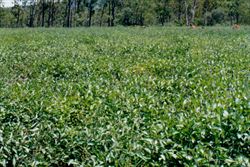
infestation (Photo: Land Protection, QDNRW)
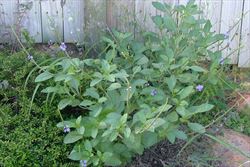
habit (Photo: Sheldon Navie)

habit (Photo: Sheldon Navie)
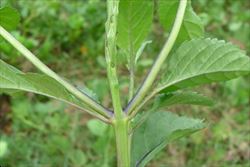
stems and paired leaves (Photo: Sheldon Navie)
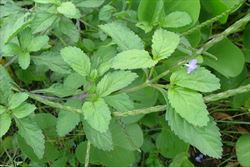
leaves and flower clusters (Photo: Sheldon Navie)
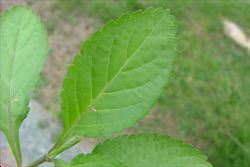
close-up of leaf with bluntly-toothed margins (Photo: Sheldon Navie)

leaf undersides (Photo: Sheldon Navie)
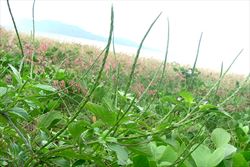
elongated flower clusters (Photo: Sheldon Navie)
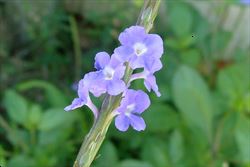
close-up of flowers (Photo: Sheldon Navie)
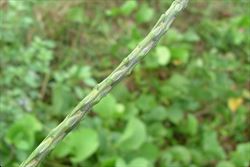
close-up of immature fruit and persistent bracts (Photo: Sheldon Navie)
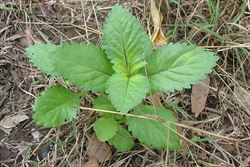
seedling (Photo: Sheldon Navie)

young plant (Photo: Sheldon Navie)
Scientific Name
Stachytarpheta jamaicensis (L.) Vahl
Synonyms
Stachytarpheta indica (L.) VahlVerbena jamaicensis L.
Family
Verbenaceae
Common Names
bastard vervain, blue porter weed, blue porterweed, blue snake weed, blue snakeweed, Brazil tea, Brazilian tea, Jamaica snakeweed, Jamaica vervain, light blue snakeweed, porterweed, snake weed, snakeweed
Origin
Native to south-eastern USA (i.e. Alabama and Florida), Mexico, Central America (i.e. Belize, Costa Rica, El Salvador, Guatemala, Honduras, Nicaragua and Panama), the Caribbean and tropical South America (i.e. French Guiana, Guyana, Surinam, Venezuela, Brazil, Colombia and Ecuador).
Cultivation
Light blue snakeweed (Stachytarpheta jamaicensis) is sometimes cultivated as a garden ornamental, particularly in the warmer parts of Australia.
Naturalised Distribution
This species is becoming widely naturalised in the northern and eastern parts of Australia. It is most common in the coastal districts of northern and central Queensland and in the northern parts of the Northern Territory. It is also relatively common in south-eastern Queensland and present in the northern parts of Western Australia, on Christmas Island and on the Cocos Islands.
Also widely naturalised in Africa, Madagascar, tropical Asia (e.g. the Philippines, Indonesia, Malaysia, Singapore, Thailand and Brunei) and on several islands in the Indian (i.e. La Réunion) and Pacific (i.e. the Cook Islands, Kiribati, the Marshall Islands, Nauru, Niue, Palau and Hawaii) Oceans.
Habitat
A weed of forests and forest margins, native bushland, roadsides, disturbed sites, waste areas, waterways, floodplains, coastal environs, gardens, plantation crops and pastures in tropical and sub-tropical regions.
Habit
A small, long-lived (i.e. perennial), shrub usually growing 50-120 cm tall, but occasionally reaching up to 2 m in height.
Distinguishing Features
- a small, long-lived, shrub with a woody rootstock that usually grows 60-120 cm tall.
- its stems are square in cross-section when young and the leaves are oppositely arranged.
- its stems and leaves are mostly hairless and its leaves have sharply, but finely, toothed margins.
- its light blue, blue or mauve flowers are arranged on long, curved, relatively thick spikes at the top of the branches.
- these flowers are tubular in shape with five broad petal lobes (about 8 mm across).
Stems and Leaves
Younger stems are green or purplish in colour, mostly hairless (i.e. glabrous) except for a few hairs near the joints (i.e. nodes), and somewhat square in cross-section (i.e. quadrangular). These branched stems are produced from a woody rootstock and tend to become rounded, light brown in colour, and somewhat woody as they mature.
The oppositely arranged leaves (2-12 cm long and 1-5 cm wide) are borne on stalks (i.e. petioles) 5-35 mm long. They are either egg-shaped in outline (i.e. ovate), oblong, or oval (i.e. elliptic) in shape and have sharply, but finely, toothed (i.e. serrate) margins. These leaves are relatively thick, slightly fleshy in nature, and often have a slight bluish or greyish tinge. They are hairless (i.e. glabrous), or have a few hairs along the veins on their undersides (i.e. sparsely strigose), and have somewhat rounded tips (i.e. obtuse apices).
Flowers and Fruit
Numerous flowers are arranged on long, curved, relatively thick spikes (15-50 cm long and 3-7 mm thick) at the top of the branches (i.e. in terminal spikes). These flowers are stalkless (i.e. sessile) and either pale blue, blue or mauve in colour. They are tubular in shape (7-11 mm long) with a slender tube and five broad petal lobes (about 8 mm across). Each flower also has five sepals (5-7 mm long), that are fused together for most of their length (i.e. into a calyx tube), and two fully developed stamens. Only a small number of these flowers are open at any one time, and each is subtended by a persistent, small, green bract (5-8 mm long and 1-2.5 mm across) with a pointed tip (i.e. acuminate apex). Flowering occurs throughout the year, but is most abundant during spring, summer and autumn.
The small oblong fruit (3-7 mm long and 1.5-2 mm across) are hairless (i.e. glabrous) and turn dark brown, dark purple or blackish in colour. These fruit (i.e. schizocarps) split into two one-seeded structures (i.e. mericarps) at maturity.
Reproduction and Dispersal
Reproduction is almost entirely by seed.
These seeds are most commonly spread in dumped garden waste, soil, and contaminated agricultural produce. They may also become attached to animals, clothing, vehicles and machinery.
Environmental Impact
Light blue snakeweed (Stachytarpheta jamaicensis) is regarded as an environmental weed in the Northern Territory and Queensland.
Legislation
This species is declared under legislation in the following states and territories:
- Northern Territory: B - spread to be controlled (throughout all of the Territory), and C - not to be introduced to the Territory. This legislation applies to all snakeweed species (i.e. Stachytarpheta spp.).
- Western Australia: Unassessed - this species is declared in other states or territories and is prohibited until assessed via a weed risk assessment (throughout the entire state).
Management
For information on the management of this species see the following resources:
- the Biosecurity Queensland Fact Sheet on snakeweeds, which is available online at http://www.dpi.qld.gov.au.
- the Northern Territory Department of Natural Resources, Environment and The Arts Agnote on snakeweeds, which is available online at http://www.nt.gov.au/weeds.
Similar Species
Light blue snakeweed (Stachytarpheta jamaicensis) is very similar to dark blue snakeweed (Stachytarpheta cayennensis), white snakeweed (Stachytarpheta australis) and pink snakeweed (Stachytarpheta mutabilis). These species can be distinguished by the following differences:
- light blue snakeweed (Stachytarpheta jamaicensis) has pale blue, blue or mauve coloured flowers (about 8 mm across) that are borne on relatively robust flower spikes (3-5 mm thick). Its stems and leaves are almost or totally hairless (i.e. glabrous), and its leaves are slightly fleshy in nature with sharply, but finely, toothed (i.e. serrated) margins.
- dark blue snakeweed (Stachytarpheta cayennensis) has dark blue, purple, or violet coloured flowers (about 5 mm across) that are borne on slender flower spikes (1-3 mm thick). Its stems and leaves are almost or totally hairless (i.e. glabrous), and its leaves have a wrinkled appearance with sharply, and deeply, toothed (i.e. serrated) margins.
- white snakeweed (Stachytarpheta australis) has pale blue or almost white coloured flowers (about 5 mm across) that are borne on relatively robust flower spikes (about 3-5 mm thick). Its stems and lower leaf surfaces are hairy (i.e. pubescent), and its leaves have a somewhat wrinkled appearance with sharply toothed (i.e. serrated) margins.
- pink snakeweed (Stachytarpheta mutabilis) has pink to reddish coloured flowers (10-12 mm across) borne on robust flower spikes (up to 7 mm thick). Its stems and both leaf surfaces are densely covered in hairs (i.e. pubescent), and its leaves are velvety in texture with sharply, but finely, toothed (i.e. serrated) margins.
Light blue snakeweed (Stachytarpheta jamaicensis) also hybridises with other species, and hybrids between it and both dark blue snakeweed (Stachytarpheta cayennensis) and pink snakeweed (Stachytarpheta mutabilis) have also become naturalised in Queensland. These hybrids exhibit characters that are intermediate between the two species involved.
It is also relatively similar to the common verbenas (Verbena litoralis and Verbena officinalis). However, the common verbenas (Verbena litoralis and Verbena officinalis) can be distinguished from dark blue snakeweed (Stachytarpheta cayennensis) by having four fully developed stamens (instead of two) and smaller flowers that are less than 4 mm across.

